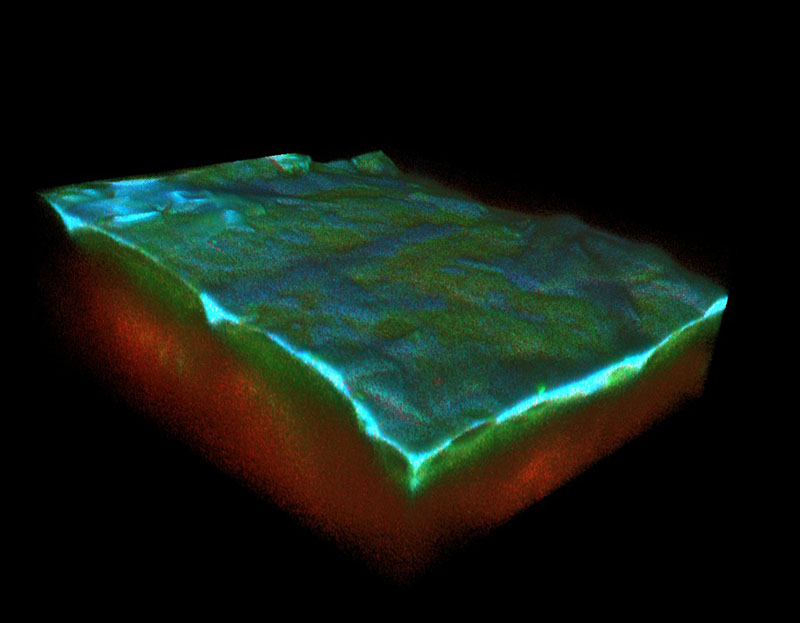NIH Grant Will Advance Study of Chronic Wound Biomarkers

In this three-dimensional reconstruction of skin, acquired through multi-photon microscopy, the outer layer, or epidermis, is identifiable through the natural auto-fluorescence of NADH, FAD and keratin, as seen in blue and green. The dermal layer is detectable in red.
FAYETTEVILLE, Ark. — The National Institutes of Health awarded a University of Arkansas biomedical engineer a new $744,992 grant to improve imaging and early detection of chronic wounds and guide treatments.
Kyle Quinn, assistant professor of biomedical engineering, uses multi-photon microscopy to create 3-D, micro-scale images of chronic wounds to measure different wound properties. The images reveal the metabolism and structure of skin layers and wound regions so that physicians can diagnose chronic wounds and determine appropriate treatment.
Chronic, non-healing wounds are caused by poor circulation, neuropathy, immobility and other factors. They affect millions of Americans and require advanced care with annual costs in billions of dollars. Infection is often a problem, and mortality rates for people with chronic wounds can exceed that of many cancers. Clinicians struggle because there are not optimal methods to diagnose a wound or evaluate appropriate therapeutic interventions.
“It’s currently a wait-and-see approach,” Quinn said. “After an initial diagnosis or checkup, the patient will come back weeks later, and the clinician will evaluate whether the wound has closed or begun closing. If it hasn’t, then the clinician will have to try some other treatment.”
With multi-photon microscopy, Quinn can exploit the intrinsic fluorescence of NADH and FAD, two cellular metabolic cofactors found in chronic wounds. These cofactors are necessary for most metabolic pathways. Multi-photon microscopy allows Quinn to build images of wound sections so he and others can detect and assess metabolic changes.
Data from a pilot phase of the research, funded by an earlier NIH award and accepted for publication in the Journal of Investigative Dermatology, indicated the ability to see differences in the metabolism of diabetic and non-diabetic wounds in frozen tissue samples. With the new grant, Quinn will non-invasively monitor individual wounds in live animals throughout the healing process. By the end of the three-year grant, he hopes to develop a suite of quantitative biomarkers to predict wound chronicity and to guide therapy. The long-term goal is to test the method in a clinical setting.
About the University of Arkansas: The University of Arkansas provides an internationally competitive education for undergraduate and graduate students in more than 200 academic programs. The university contributes new knowledge, economic development, basic and applied research, and creative activity while also providing service to academic and professional disciplines. The Carnegie Foundation classifies the University of Arkansas among only 2 percent of universities in America that have the highest level of research activity. U.S. News & World Report ranks the University of Arkansas among its top American public research universities. Founded in 1871, the University of Arkansas comprises 10 colleges and schools and maintains a low student-to-faculty ratio that promotes personal attention and close mentoring.
Contacts
Kyle Quinn, assistant professor, Department of Biomedical Engineering
College of Engineering
479-575-5364,
kpquinn@uark.edu
Matt McGowan, science and research communications officer
University Relations
479-575-4246,
dmcgowa@uark.edu
Headlines
Affairs of the Heart
Find out how biomedical engineering professor Morten Jensen is developing innovative devices to produce better outcomes in cardiovascular medicine.
Students, Faculty and Alumni Kick Off Centennial Year of School of Law
Founded April 14, 1924, the School of Law faculty, students and alumni started the celebration of its centennial year with a Founders Day event and will continue with more commemorative events this coming fall.
Yearly Academic Award Winners, Ambassadors Recognized by Bumpers College
Schyler Angell, Lexi Dilbeck, Cason Frisby, Tanner Austin King, Anna Brooke Mathis, Carrie Ortel, Lucy Scholma, Kadence Trosper and student ambassadors were honored at the college's annual reception.
World Premiere of 'Cries from the Cotton Field' Slated for May 8
Cries from the Cotton Field chronicles the journey of 19th century Italian immigrants from northern Italy to the Arkansas Delta and ultimately to Tontitown. It will premier at 6 p.m. May 8 in Springdale Har-Ber High School.
Fay Jones School's Earth Day Event Spotlights Sustainable Materials and Projects
"One day doesn't seem like a lot, but one day can empower individuals and groups, energize them to work for change and innovate for transformative solutions," professor Jennifer Webb said of the students' design work.




